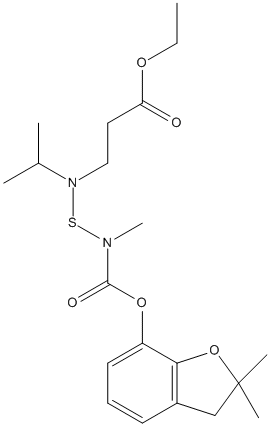Benfuracarb
General
Type : Insecticide,Carbamate,Sulfur Compound,Benzofuran,Propionate
Chemical_Nomenclature : ethyl 3-[[(2,2-dimethyl-3H-1-benzofuran-7-yl)oxycarbonyl-methylamino]sulfanyl-propan-2-ylamino]propanoate
Canonical SMILES : CCOC(=O)CCN(C(C)C)SN(C)C(=O)OC1=CC=CC2=C1OC(C2)(C)C
InChI : InChI=1S\/C20H30N2O5S\/c1-7-25-17(23)11-12-22(14(2)3)28-21(6)19(24)26-16-10-8-9-15-13-20(4,5)27-18(15)16\/h8-10,14H,7,11-13H2,1-6H3
InChIKey : FYZBOYWSHKHDMT-UHFFFAOYSA-N
Other name(s) : Oncol,Aminofuracarb,Furacon,Oncol 5G
MW : 410.52
Formula : C20H30N2O5S
CAS_number : 82560-54-1
PubChem : 54886
UniChem : FYZBOYWSHKHDMT-UHFFFAOYSA-N
IUPHAR :
Wikipedia :

Target
References (6)
| Title : Mutagenic and cytotoxic activities of benfuracarb insecticide - Eren_2016_Cytotech_68_637 |
| Author(s) : Eren Y , Erdogmus SF , Akyil D , Ozkara A |
| Ref : Cytotechnology , 68 :637 , 2016 |
| Abstract : Eren_2016_Cytotech_68_637 |
| ESTHER : Eren_2016_Cytotech_68_637 |
| PubMedSearch : Eren_2016_Cytotech_68_637 |
| PubMedID: 25381170 |
| Title : Multivariate analysis of toxicological and environmental properties of soil nematicides - Sanchez-Moreno_2009_Pest.Manag.Sci_65_82 |
| Author(s) : Sanchez-Moreno S , Alonso-Prados E , Alonso-Prados JL , Garcia-Baudan JM |
| Ref : Pest Manag Sci , 65 :82 , 2009 |
| Abstract : Sanchez-Moreno_2009_Pest.Manag.Sci_65_82 |
| ESTHER : Sanchez-Moreno_2009_Pest.Manag.Sci_65_82 |
| PubMedSearch : Sanchez-Moreno_2009_Pest.Manag.Sci_65_82 |
| PubMedID: 18823060 |
| Title : Reproductive effects in German cockroaches by ecdysteroid agonist RH-0345, juvenile hormone analogue methoprene and carbamate benfuracarb - Maiza_2004_Commun.Agric.Appl.Biol.Sci_69_257 |
| Author(s) : Maiza A , Kilani S , Farine JP , Smagghe G , Aribi N , Soltani N |
| Ref : Commun Agric Appl Biol Sci , 69 :257 , 2004 |
| Abstract : Maiza_2004_Commun.Agric.Appl.Biol.Sci_69_257 |
| ESTHER : Maiza_2004_Commun.Agric.Appl.Biol.Sci_69_257 |
| PubMedSearch : Maiza_2004_Commun.Agric.Appl.Biol.Sci_69_257 |
| PubMedID: 15759422 |
| Title : Effect of some granular insecticides currently used for the treatment of maize crops (Zea mays) on the survival of inoculated Azospirillum lipoferum - Revellin_2001_Pest.Manag.Sci_57_1075 |
| Author(s) : Revellin C , Giraud JJ , Silva N , Wadoux P , Catroux G |
| Ref : Pest Manag Sci , 57 :1075 , 2001 |
| Abstract : Revellin_2001_Pest.Manag.Sci_57_1075 |
| ESTHER : Revellin_2001_Pest.Manag.Sci_57_1075 |
| PubMedSearch : Revellin_2001_Pest.Manag.Sci_57_1075 |
| PubMedID: 11721526 |
| Title : Determination of five pesticide residues in oranges by matrix solid- phase dispersion and liquid chromatography to estimate daily intake of consumers - Valenzuela_2001_J.AOAC.Int_84_901 |
| Author(s) : Valenzuela AI , Pico Y , Font G |
| Ref : Journal of AOAC International , 84 :901 , 2001 |
| Abstract : Valenzuela_2001_J.AOAC.Int_84_901 |
| ESTHER : Valenzuela_2001_J.AOAC.Int_84_901 |
| PubMedSearch : Valenzuela_2001_J.AOAC.Int_84_901 |
| PubMedID: 11417653 |
| Title : Antidotal action of atropine sulfate against insecticide benfuracarb poisoning in rats - Ichikawa_1995_J.Toxicol.Sci_20_143 |
| Author(s) : Ichikawa S , Goto T , Umetsu N |
| Ref : Journal of Toxicological Sciences , 20 :143 , 1995 |
| Abstract : Ichikawa_1995_J.Toxicol.Sci_20_143 |
| ESTHER : Ichikawa_1995_J.Toxicol.Sci_20_143 |
| PubMedSearch : Ichikawa_1995_J.Toxicol.Sci_20_143 |
| PubMedID: 7473892 |